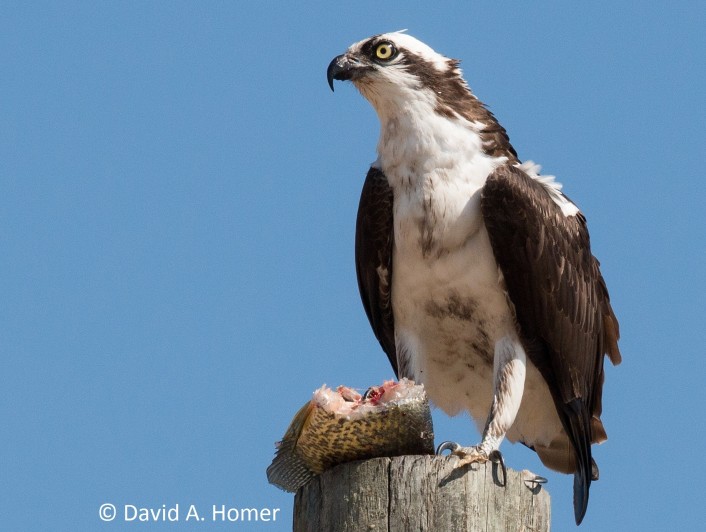No matter where it is I travel, one bird I can usually count on seeing is the Osprey. Ospreys are one of the most widespread birds in the world and can be found on all continents except Antarctica. They are not difficult to identify as they are one of the largest birds of prey in North America with a wingspan of about five feet.
Osprey feed almost exclusively on a diet of fish so they stay close to water. They will nest on just about anything that rises into the air, as long as there is no significant undergrowth around the base: utility poles, dead tree snags, old windmills and even made-made platforms. However, Real Estate plays a key role when the females chose their mate. Location, location, location! They will stray inland up to 5-6 km if they have to in order to find a suitable location for a nest.
The nest is made of tree branches and twigs but I have seen all kinds of materials making up a nest; hay bail twin, garbage bags, and even bits of plastic toys. Pairs, which normally mate for life, tend to return to the same nest site every year, adding more nesting material each year . Nests of up to 3 m in diameter are not uncommon.
The female lays 2-4 creamy white and brown eggs in mid-May which are incubated for about 40 days. Then the real work begins for the male as he provides all the food for the family while the female stands guard at the nest; sheltering the young from the sun and rain and tearing the fish brought by the male into bit sized pieces for the young. The male searches out its prey by flying high above the water, hovering and then upon spotting the fish will plummet feet-first snapping its tanons closed around the fish in an instant. The outer talon on each foot can rotate and while the bird is shaking off the water like a wet dog in order to become airborne again, will rotate the fish so that its head faces forward. They will eat a variety of fish up to about 12 inches long.
When the young are fledged at about 50 days, the parents will coax them off the nest by siting in nearby trees or on utility poles close by and calling to them. It can be quite comical to watch a parent teaching its young to fish. In the early stages, the young will just flop into the water time and time again with no reward at all. When they are able to care for themselves, the parents will cease bring them food and abandon them.
Osprey migration takes place in the early fall when they seek out open and fish laden waters of Florida, Central America and the Caribbean.
In the mid -20th century we almost lost these magnificent birds as they were seriously endangered as a species by the effects of the use of pesticides. However Ospreys have made a remarkable comeback following the banning of DDT and other pesticides during the 1979’s.
Today the nests of these magnificent birds dot the landscape as one travels around lake country.
Written by David A. Homer

